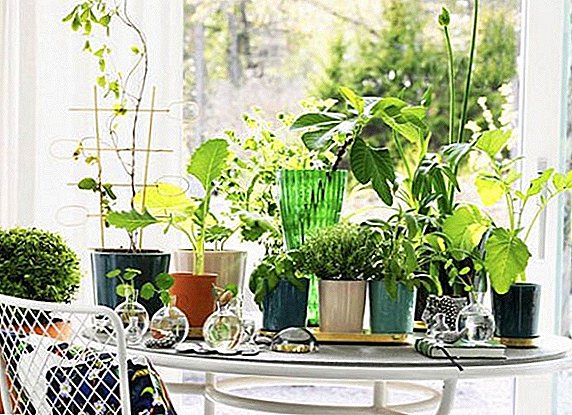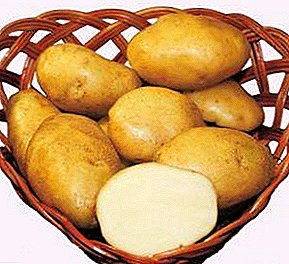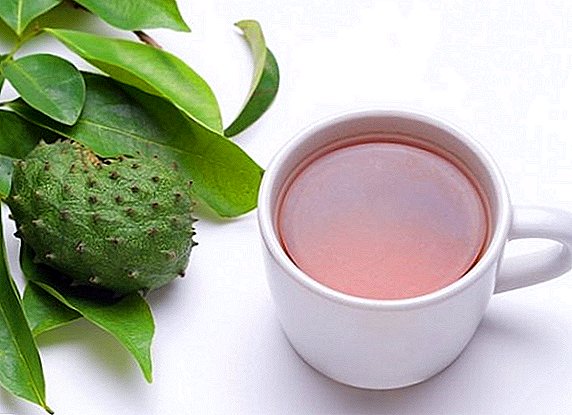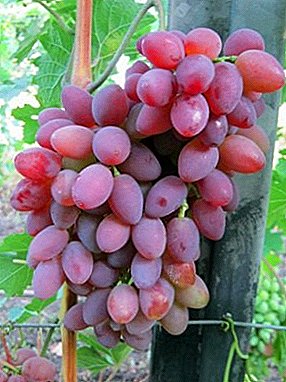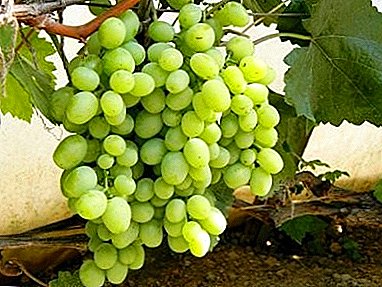
Kesha. So usually called pets.
But in this case we will talk about table grapes popular with gardeners, which in scientific circles were encrypted with the code FV-6-5.
True, the popular rumor, noting all the selectional nuances, continued to lovingly endow it with spiritual and significant names: “Kesha-1”, “Kesha-2”, “Super Kesha”, “Kesha Muscat”, “Zlatogor”, “Tamerlan” and The most popular is "Talisman".
What is so fond of this grape?
- The clusters of Keshi ripen earlier than other varieties.
- The harvest is distinguished by stable generosity.
- Young shoots are ready to make for the season up to 2-3 full bunches.
- Excellent propagated by grafting and vaccinations.
- Seedlings are capable of early fruition.
- Not afraid of transportation.
- Painlessly tolerates low winter temperatures (down to -23 ° C).
- Resistant to typical diseases of grapes: mildew, oidium, gray rot.
All these qualities in addition to the original flavor and taste make "Kesha" the relevant requirements of an elite brand.
Table varieties also include Karmakod, Alexander and Lily of the Valley.
Its features like table varieties
 The main feature of table grapes, which include the described sample, are:
The main feature of table grapes, which include the described sample, are:
- delicious taste;
- thin skin;
- berry size;
- the appearance of the brush;
- complex associative flavor;
- the usefulness of the chemical composition of the juice.
By the color of the fruit, table varieties are divided into four groups, but Kesha is represented only by white and red grapes, based on the heredity of the parents.
White varieties include such varieties as Lancelot, Bianka and Husayne Bely.
What gave noble parents?
And they are notable because in the homeland, in Moldova, the variety "Frumoasa Albe" is extremely popular under the name "White Beauty" and placed on a par with the variety "Queen of Vineyards". The name of the other parent reflected all the power of the feelings experienced by the team of breeders of the VNII. Potapenko, when they received it in artificial conditions, - “Delight”.
From "Frumoasa Albe" borrowed a new variety:
- extraordinary sweetness of the fruit;
- the harmony of taste and aroma;
- capacity for strong growth;
- immaculate pollination;
- high yield;
- resistance to disease (even phylloxera!);
- frost resistance is higher than general - up to -25 ° C;
- prolonged preservation of the brush on the bush after ripening without loss of taste.

Frost resistance can also boast Arched, Isabella and Pink Flamingo.
From "Delight" inherited:
- power trunks, well performing the function of the stock;
- the size and weight of the brush (up to 1.5 kg);
- high sugar content (up to 26%) and acidity (up to 9 g / l);
- suitability for storage without loss of taste for a month;
- increased resistance to frost;
- resistance to typical grape diseases.
Among the resistant varieties also worth paying attention to the Elegant, Citron Magaracha and Angelica.
Place of Birth
Like most new hybrids, grapes FV-6-5 appeared in the special breeding nursery VNIIVIV in the Kuban, or rather - in Novocherkassk. From the middle of the last century, this breeding center prepared for testing 75 varieties, of which 50 are inter-specific hybrids.
The main goal of the team is the varietal promotion of grapes in harsh areas of the European part of the country and Siberia. The amateur winegrowers help them actively in this on their personal plots, bringing new characteristics of the variety to the result of sustainable inheritance.
 Hybridization of the variety is carried out:
Hybridization of the variety is carried out:
- in the process of pollination of the bush more productive variety;
- in grafting a promising "newcomer" to a proven stock (vegetative);
- in the selection of cloning results of the best copies;
- artificially.
So for many generations, the Kesha variety was given all the new qualitative and agro-cultural characteristics, which was reflected in the synonymous series of its names.
Modifications: "Kesha 1" (Talisman), "Kesha 2", "Kesha Red"
Grapes of the described variety are characterized as:
- strong-growing, with large bright leaves that stand out until the fruit ripens;
- having a strong root system;
- self-pollinated;
- early ripening (up to 130 days);
- with fruitfulness of shoots up to 90%;
- consistently high-yielding, with increased load of adult bushes;
- successful reproduction by grafting with subsequent fruiting in 3-4 years;
- having high transportability;
- able to resist fungal infections;
- frost-resistant (to-23 ° C).

During the fruiting period, cone-shaped or indefinite forms of the brush are formed, differing in:
- medium density;
- long comb;
- weighing up to 1.5 kg;
- load - 1-2 hands on the shoot;
- long-lasting, without loss of taste.
As a table variety "Kesha" characterizes the quality of the berries, which are:
- have a predominantly sweet taste, which is determined by sugar accumulation to 24%, and the acidity of all 5 g / l;
- differ in a dense consistence;
- have a dense, but easily bite through the skin;
- combine nutmeg or nutmeg-pineapple flavor;
- hold a tasting score at level 8;
- are large enough (up to 15 g) with 2-3 bones;
- have an oval shape;
- light green in color or milky white, cream;
- ripe berries do not burst and can be stored in a brush for up to 1 month.
We try to understand the numerous family.
"Kesha" - starting varietyOn the fertile basis of which other modifications were obtained:
- "Kesha 1" ("Super Kesha" or "Mascot") - a hybrid, characterized by increased resistance to diseases and low temperatures (at shelter - up to -25 ° C); its berries are even larger, and the time of ripening is later; prone to overload; seedlings after planting in the ground ready for fruiting in the 2nd year.
- "Kesha 2" ("Kesha nutmeg", "Zlatogor", "Tamerlan", "Kesha Radiate") - a hybrid as a result of crossing Kishmish radiant with "Keshei1" (selection VN Kraynov);
When ripe, large berries acquire an amber color and a pronounced nutmeg aroma; conical brush with a "wing"; ripening time reduced to 115 days; when sheltering frost resistance - up to -26 ° C.
- "Kesha Red" - national hybrid as a result of crossing Keshi1 and Cardinal variety (table grapes of southern Europe); very vigorous plant with an average ripening period;
The clusters are round or conical of average density; the weight of the brush with good care reaches 2 kg; large, rounded berries of all shades of cherry color are covered with a light wax coating (pruino); the structure of the berries on the type of Cardinal; the harmonious taste of the fruit is accompanied by an apple tone; in the main characteristics repeats Kesha 1:
- high yields;
- transportable;
- resistant to fungal diseases;
- has high fruitfulness of escapes;
- long-lasting, without loss of taste;
- frost resistance - up to -26 ° C.
Photo grapes "Kesha Talisman":


Bogatyanovskiy, Druzhba and Veles also possess muscatel scent.
Photo grapes "Kesha Tamerlan":

Photo grapes "Kesha Red":

More photos of grapes "Kesha":



How to root in your garden?
- First you need to find the right place for the southern guest. The best choice would be the sunny side of the wall of the house or other buildings that will protect the plant from the winds.Preferred deep groundwater and fertile soil. In order not to destroy the structure, for the vine you need to create a reliable support 40 cm from the wall.
Planting seedlings optimally planned for spring, when the earth is already warm to 10 ° C, and the air temperature will become stable positive (15 ° C).
The pit is prepared in advance, even in the fall, filling it with humus and fertile soil.An indicator of proper fit is the position of the root collar, which should always remain above the ground surface. To strengthen the seedling tied to a support, then - plentifully watered (up to 30 liters under the trunk).
Vines, planted under the winter, must be warmed, creating a structure of hollow capacity and soil, so as not to damage the escape.
- Grafting with a handle allows you to get a harvest sooner, but it requires special careful preparation and operation:
- cutting and stock prepared in advance; the first one is pruned with a wedge and kept in a solution of the “Gumat” preparation;
- old bush is cut, carefully cleaning the cut surface;
- neatly split the shtamb with a hatchet, trying not to damage the plant;
- The Keshi stalk is inserted into the split and the string is pulled over the cloth;
- create a backup for the stock.
Important: Grafting is better if the stock has a large stock of perennial wood. The soil should contain 15 mg / 100g of phosphorus and potassium.
Special care
 And the large-fruited variety can grieve with small sour berries, if the complex of agrotechnical measures is disturbed:
And the large-fruited variety can grieve with small sour berries, if the complex of agrotechnical measures is disturbed:
- watering - twice at the beginning of the season (before budding and after flowering); in case of severe drought, additional moisture will be relevant;
- introduction of phosphorus-potassium and nitrogenous fertilizers without exceeding the norm; Boron is used as a trace element to prevent berries from peeling;
- the formation of the crown on the trellis with pruning to sap flow, to regulate the number of shoots; autumn pruning is also used to increase reproduction;
- rationing of clusters in order to avoid overloading (one cluster per escape); in dry climates, one can leave half of the ovary;
- prevention of diseases using a 1% solution of Bordeaux mixture (a mixture of solutions of freshly quenched lime and copper sulphate) - twice per season;
- during the period of ripening of grapes, it is important to protect it from "freeloaders" from the world of birds and insects (wasps). To do this, use a wrap separately brushes mesh fabric (such as gauze) or, for large areas of landings, stretching the fine-meshed mesh on the entire trellis. Noise scarers are ineffective.
Use
Eating fresh grapes should be observed following rules:
- it is necessary to eat fruit between meals, not less than an hour after eating;
- you can eat berries together with bones;
- You should not combine it with carbonated drinks, chocolate, kefir or milk;
- the daily rate of grapes with a healthy diet is not more than 0.5 kg;
- pregnant women in the last terms of this fruit is better to give up.
With the generally accepted calorie grapes with its help you can lose weight using a special diet (3 days to eat only its berries, eating a day before 1,5 kg, and then 2 weeks to replace dinner with a useful berry).
Princess Olga, Russian Concord and Ideal Delight also have healing properties.


